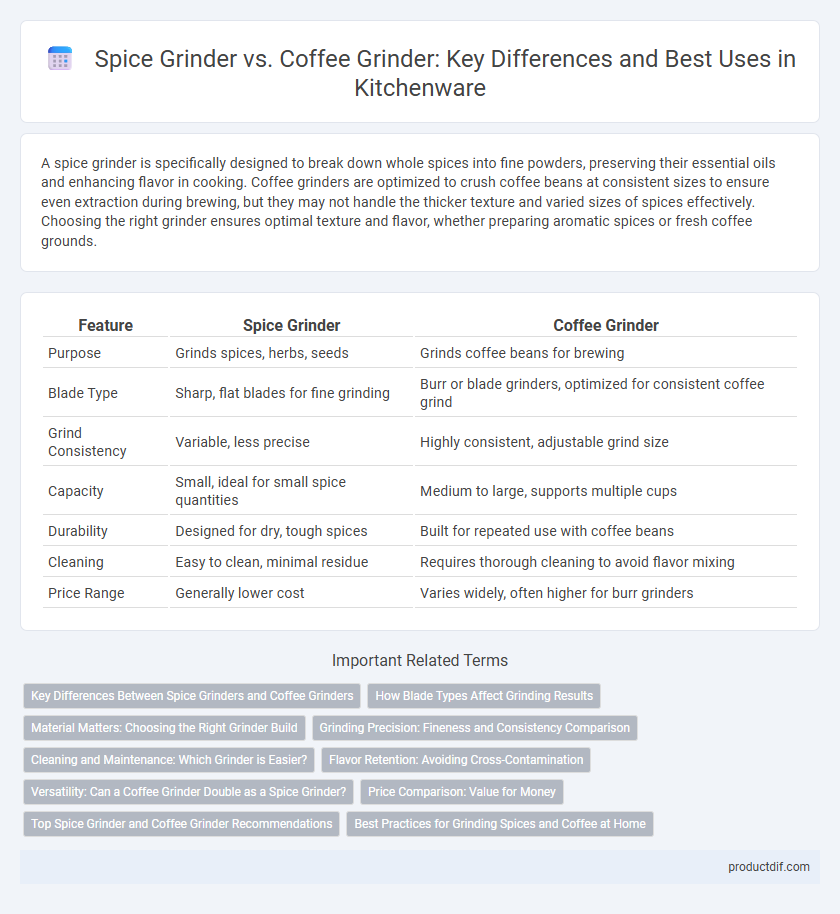A spice grinder is specifically designed to break down whole spices into fine powders, preserving their essential oils and enhancing flavor in cooking. Coffee grinders are optimized to crush coffee beans at consistent sizes to ensure even extraction during brewing, but they may not handle the thicker texture and varied sizes of spices effectively. Choosing the right grinder ensures optimal texture and flavor, whether preparing aromatic spices or fresh coffee grounds.
Table of Comparison
| Feature | Spice Grinder | Coffee Grinder |
|---|---|---|
| Purpose | Grinds spices, herbs, seeds | Grinds coffee beans for brewing |
| Blade Type | Sharp, flat blades for fine grinding | Burr or blade grinders, optimized for consistent coffee grind |
| Grind Consistency | Variable, less precise | Highly consistent, adjustable grind size |
| Capacity | Small, ideal for small spice quantities | Medium to large, supports multiple cups |
| Durability | Designed for dry, tough spices | Built for repeated use with coffee beans |
| Cleaning | Easy to clean, minimal residue | Requires thorough cleaning to avoid flavor mixing |
| Price Range | Generally lower cost | Varies widely, often higher for burr grinders |
Key Differences Between Spice Grinders and Coffee Grinders
Spice grinders are designed with blades or burrs optimized to handle a variety of textures, allowing them to efficiently crush seeds, herbs, and tough spices without losing flavor integrity. Coffee grinders, particularly burr grinders, focus on uniformly grinding coffee beans to precise sizes, preserving aroma and ensuring consistent extraction during brewing. The primary differences lie in blade design, grinding mechanisms, and the ability to adapt to different ingredient hardness and oil content.
How Blade Types Affect Grinding Results
Blade types significantly impact the grinding results in both spice grinders and coffee grinders, where flat blades create a consistent coarse grind ideal for coffee brewing methods like French press. Serrated blades excel in grinding tough spices by producing a uneven, coarser texture suitable for enhancing flavor release. Burr grinders, commonly preferred for coffee, offer precise, adjustable grinding sizes that maintain aroma and prevent overheating, a feature rarely found in typical spice blade grinders.
Material Matters: Choosing the Right Grinder Build
Choosing the right grinder build is essential for both spice and coffee grinding, with materials like stainless steel offering durability and resistance to corrosion, while ceramic provides a non-reactive surface that preserves flavor integrity. Stainless steel blades excel in handling hard spices and coffee beans, delivering consistent grinding performance, whereas ceramic grinders reduce heat buildup, preventing flavor loss and bitterness. Prioritizing material quality ensures optimal grinding results, longevity, and maintains the distinct aromas of spices and coffee.
Grinding Precision: Fineness and Consistency Comparison
Spice grinders deliver variable grinding precision tailored to diverse spice textures, offering adjustable fineness but often less uniform consistency due to the irregular size of spices. Coffee grinders prioritize consistent particle size to optimize extraction, utilizing burr or blade mechanisms that ensure uniform grounds essential for brewing quality coffee. The fineness in coffee grinders is more controllable and stable, while spice grinders emphasize versatility over absolute consistency.
Cleaning and Maintenance: Which Grinder is Easier?
Spice grinders typically require more frequent cleaning due to the oily and sticky residues left by various spices, making maintenance more labor-intensive compared to coffee grinders. Coffee grinders often have simpler designs with removable parts, allowing easier cleaning of burrs or blades to prevent coffee buildup and stale residue. For optimal hygiene, both grinders benefit from regular cleaning, but coffee grinders generally offer a more straightforward maintenance routine.
Flavor Retention: Avoiding Cross-Contamination
A spice grinder is designed to prevent flavor cross-contamination by using materials and blade designs that minimize lingering odors, ensuring pure spice flavors. Coffee grinders often absorb oils and aromas from beans, which can affect the taste of spices if used interchangeably. For optimal flavor retention, dedicated grinders for spices and coffee are recommended to preserve the distinct profiles of each.
Versatility: Can a Coffee Grinder Double as a Spice Grinder?
Coffee grinders offer a suitable solution for grinding both coffee beans and spices, enhancing kitchen versatility by reducing the need for multiple appliances. Their fine and consistent grind capability adapts well to various spices such as peppercorns, cumin, and coriander, making them a practical choice for both brewing and cooking purposes. However, frequent switching between coffee and spices may lead to flavor contamination, requiring thorough cleaning to maintain taste integrity.
Price Comparison: Value for Money
Spice grinders typically cost between $15 and $40, offering affordable options for occasional use and small quantities, while coffee grinders range from $20 to over $200 depending on features and grinding precision. For budget-conscious buyers, spice grinders provide excellent value for simple tasks, but investing in a higher-priced coffee grinder yields more consistent grind size and enhanced flavor extraction. The choice depends on intended use; spice grinders excel in affordability, whereas coffee grinders justify higher prices through specialized performance.
Top Spice Grinder and Coffee Grinder Recommendations
Top spice grinders, such as the KRUPS F203 Electric Spice and Coffee Grinder, offer versatile grinding options with stainless steel blades designed for coarse to fine textures suitable for various spices. For coffee enthusiasts, the Baratza Encore Conical Burr Coffee Grinder is highly recommended for its precise grind settings and consistent particle size, enhancing flavor extraction during brewing. Both grinders excel in their respective categories by combining durability, ease of use, and efficiency, making them essential tools in any well-equipped kitchen.
Best Practices for Grinding Spices and Coffee at Home
For optimal spice grinding, use a dedicated spice grinder with burr mechanisms to preserve essential oils and achieve consistent particle size, avoiding flavor cross-contamination from coffee residues. Coffee grinders designed with adjustable grind settings and flat or conical burrs deliver uniform grounds that enhance extraction quality for various brewing methods. Regular cleaning and separate equipment for spices and coffee maintain flavor integrity and extend the lifespan of your kitchen appliances.
Spice Grinder vs Coffee Grinder Infographic

 productdif.com
productdif.com